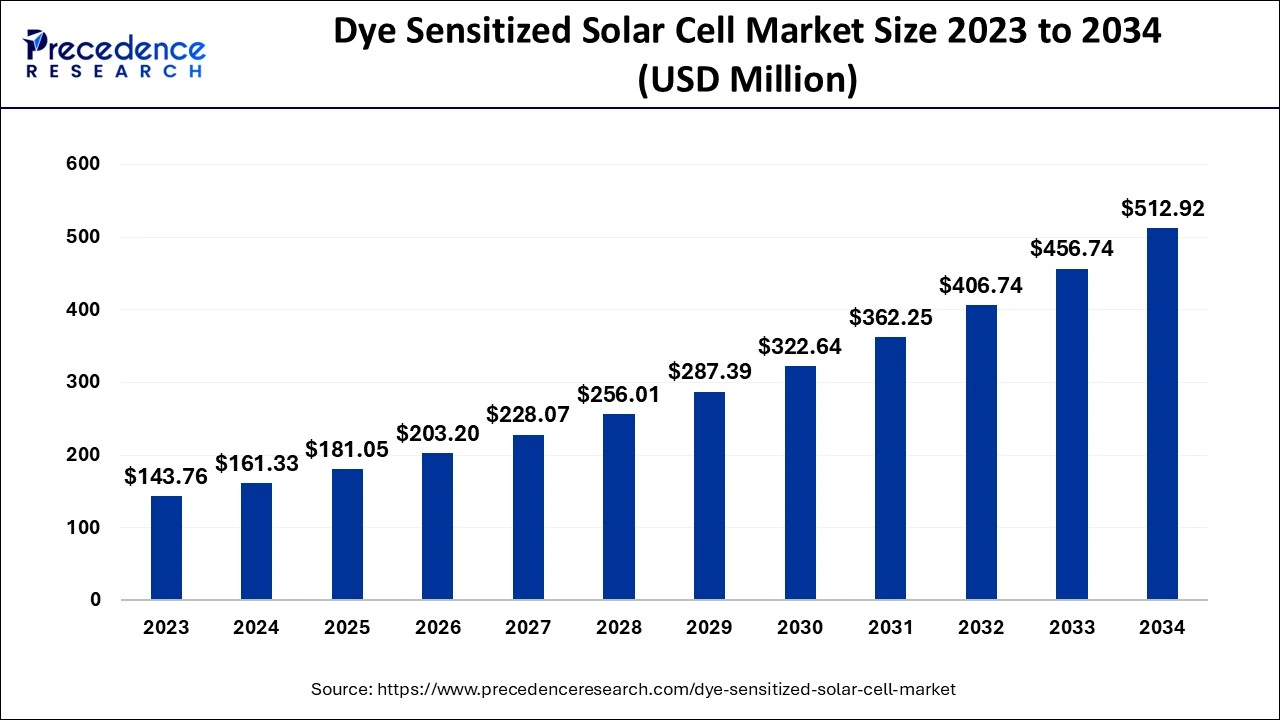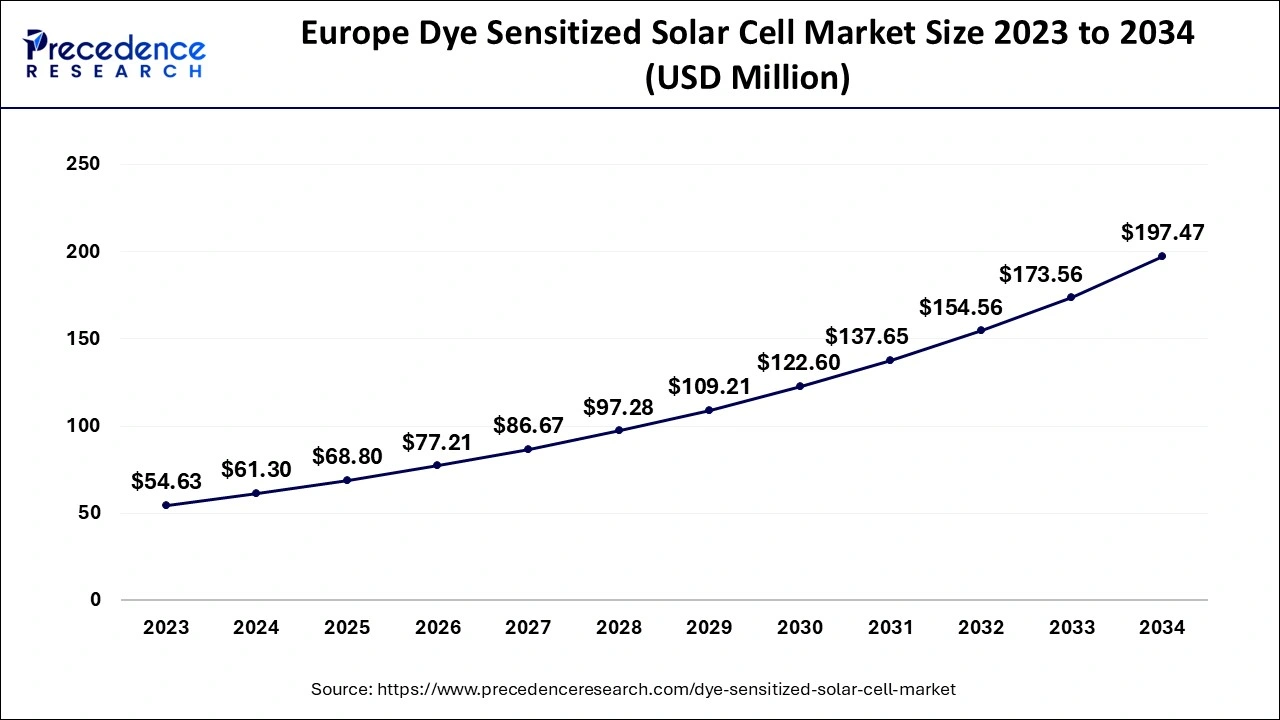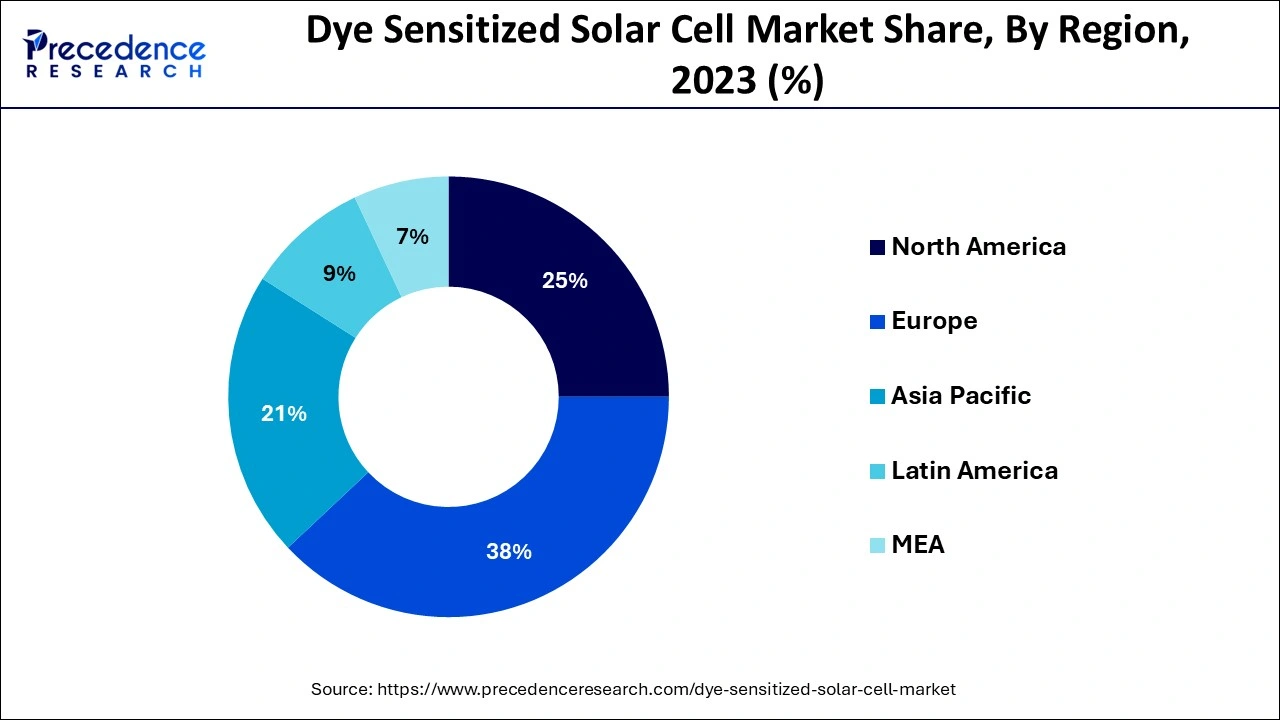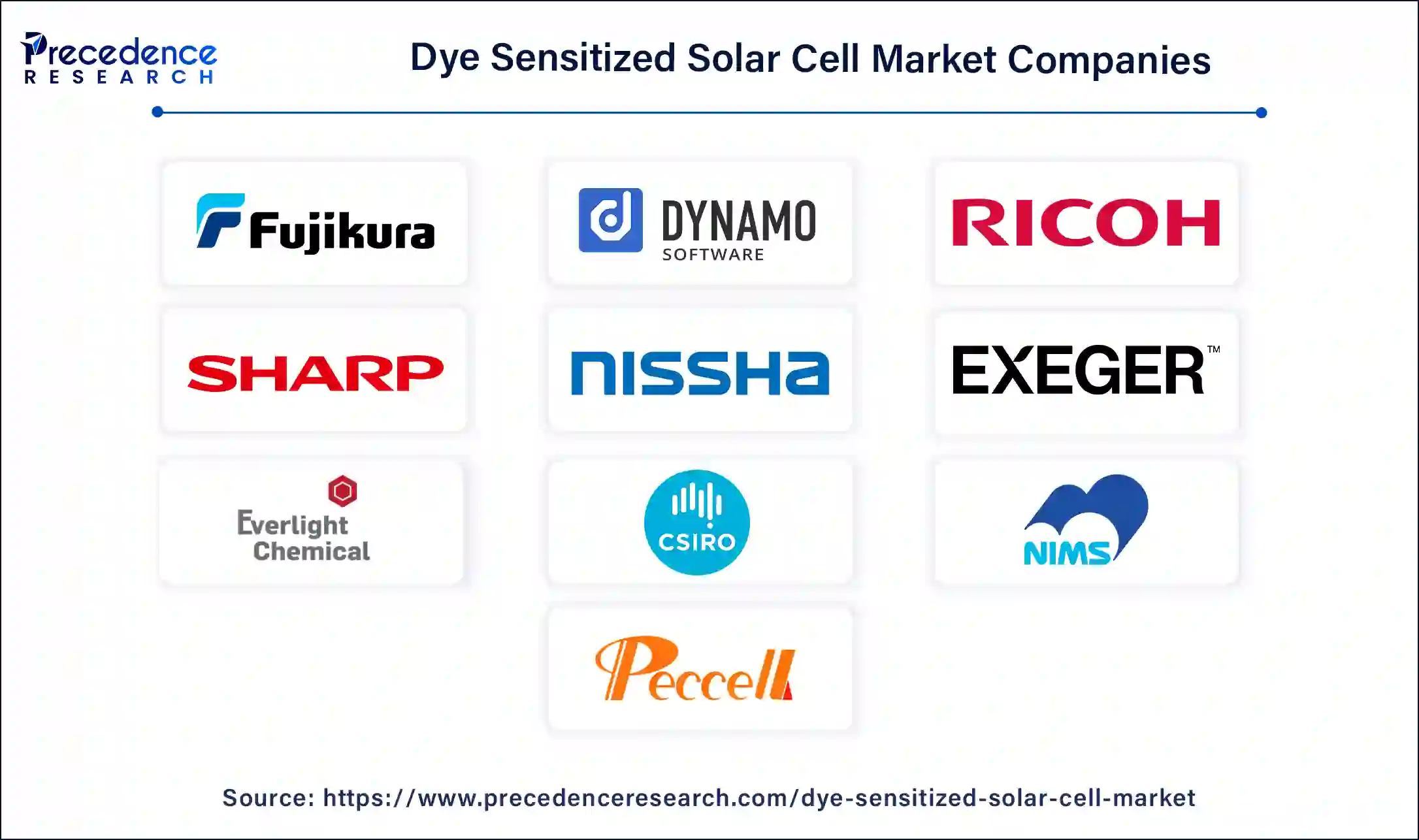October 2024
The global dye sensitized solar cell market size accounted for USD 161.33 million in 2024, grew to USD 181.05 million in 2025 and is projected to reach around USD 512.92 million by 2034, registering a CAGR of 12.26% between 2024 and 2034. The Europe dye sensitized solar cell market size is exhibited at USD 61.30 million in 2024 and is registering at a CAGR of 12.39% during the forecast year.
The global dye sensitized solar cell market size is calculated at USD 161.33 million in 2024 and is expected to exceed USD 512.92 million by 2034, expanding at a CAGR of 12.26% from 2024 to 2034. The increasing demand for aesthetically appealing and advanced solar panels by the commercial and residential sectors is driving the growth of the dye sensitized solar cell market.

The integration of AI into the dye sensitized solar cell market plays a significant role in solar generation. Artificial intelligence algorithms analyze meteorological data to predict precise forecasts, improve grid management, and increase solar output. AI also helps in detecting potential hazards through predictive maintenance, it transforms the overall operations of solar panels. Machine learning technology continuously monitors solar installations, and maintenance costs, reducing downtime, while increasing the lifespan of solar equipment.
The Europe dye sensitized solar cell market size is estimated at USD 61.30 million in 2024 and is expected to be worth around USD 197.47 million by 2034, growing at a CAGR of 12.39% from 2024 to 2034.

Europe dominated the global dye sensitized solar cell market in 2023. The rising growth of the market in the region is owing to the continuous rising investment in the development of solar energy development including the dye sensitized solar cell with aesthetically appealing infrastructure is driving the growth of the market. The regional countries are highly participating in reducing carbon emissions and their footprint in the environment. Additionally, the rising government intervention in energy development and the adaptation of renewable sources of energy in power generation in the region.

Asia Pacific is expected to grow at the fastest rate in the dye sensitized solar cell market during the forecast period. The growth of the market is attributed to the rising demand for the energy and power sector due to the rising population, increasing industrial infrastructure, and urbanization. The rising concern about environmental pollution and increasing carbon footprint due to nonrenewable energy production is driving the adoption of renewable sources of energy such as solar energy installation of the solar cell.
The dye sensitized solar cell are the device that is used to convert solar energy into electric energy by using the light-sensitized technology implemented on the wide energy band semiconductor. It is a cost-efficient solution for solar cells belonging to the thin film solar cell group. It is the class of photoelectrochemical cells. It has the capacity for easy scale-up, low production cost, good performance under weak/diffuse light, and can be installed in the windows glass of buildings and flexible substrates.
| Report Coverage | Details |
| Market Size by 2034 | USD 512.92 Million |
| Market Size in 2024 | USD 161.33 Million |
| Market Size in 2025 | USD 181.05 Million |
| Market Growth Rate from 2024 to 2034 | CAGR of 12.26% |
| Largest Market | Europe |
| Base Year | 2023 |
| Forecast Period | 2024 to 2034 |
| Segments Covered | Application and Regions |
| Regions Covered | North America, Europe, Asia-Pacific, Latin America and Middle East & Africa |
Increasing awareness regarding carbon footprint
The rising literacy rate in the global population makes them aware of the environment and pollution level. The rising global warming due to the higher consumption of non-renewable sources of energy is driving the demand for the dye sensitized solar cell market which results in the higher consumption of solar panels for electricity generation with cost-efficient and long-term usage. The increasing adoption of solar panels for electricity generation from the residential as well as the commercial sector contributes to reducing carbon emissions.
Temperature stability
The design of the dye sensitized solar cell uses a liquid electrolyte that has limitations in temperature stability, electrolytes can freeze at a low temperature which hampers the efficiency of the devices and hampers the growth of the dye sensitized solar cell market.
Advancements in dye sensitized solar cells
The continuous research and development program in the evaluation of technologies in the dye sensitized solar cell is driving future growth opportunities in the dye sensitized solar cell market. Technological advancements such as semiconductor materials, photoactive dyes, electrolyte design, and tandem configuration help in improving the stability and efficiency of dye sensitized solar cells, and the rising adoption of sustainability solutions in energy consumption.
The portable charging segment dominated the dye sensitized solar cell market in 2023. The growth of the segment is attributed to the rising adoption of portable, smart, and flexible electronic devices are driving the demand for portable charging devices. The dye sensitized solar cells play an important part in the portable charging devices for efficiently charging the electronic applications. The portable charging devices are cost-efficient, flexible, and lightweight which makes them ideal for charging the devices while moving. The rising advancements in portable electronic devices and the increasing penetration of smartphones further drive the demand for dye-sensitized solar cells for utilizing solar energy to charge electronic devices. The increasing penetration of smartphone users drives the demand for efficient power charging systems.
The BIPV/BAPV segment will expand rapidly in the dye sensitized solar cell market during the forecast period. The rising adoption of the BIPV/BAPV in residential and commercial buildings for solar energy utilization and the rising concern regarding global warming, increasing pollution levels, and carbon footprint by nonrenewable energy production are driving the adoption of renewable sources of energy. The cost efficiency, the increasing cost of energy, and rising urbanization across the world are driving the demand for electricity and are further driving the demand for BIPV.

By Application
By Geography
For inquiries regarding discounts, bulk purchases, or customization requests, please contact us at sales@precedenceresearch.com
No cookie-cutter, only authentic analysis – take the 1st step to become a Precedence Research client
October 2024
August 2024
January 2025
August 2024